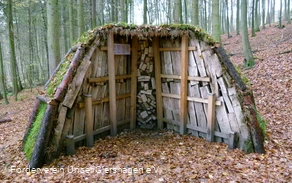The Kluskirche church in Niederuppsprunge was built in the 12th century on the site of a chapel from the Carolingian period. It was originally a single-nave Romanesque building with a square tower designed as a windowless fortified tower. The original Romanesque building was extended in 1682 by the Bredelar abbot Absalom Heuck with a square bay and a choir end to the east. This extension stands out clearly from the older part due to its groined cross vaults.
In 1700, the church received a new Baroque altar, which, like many wayside shrines in the Giershagen area, was made by the Papen workshop. The sculptor's workshop of Heinrich Papen (1645-1719) and his son Christophel (1678-1735) in Giershagen was one of the leading and most creative workshops of the Baroque period in Westfalen. They worked with alabaster, marble and flourstone, the stones found in the surrounding area. They left behind an extensive collection of over 160 artistic monuments, including more than 40 altars, in more than 50 locations in Westfalen and northern Waldeck.
The Kluskirche, which had Saints Fabian and Sebastian as its patron saints, became a place of pilgrimage early on and was also credited with miraculous healings. Many utensils left behind by pilgrims in the church bear witness to this. Once a year, a solemn procession to the Kluskirche took place with a large turnout from the neighborhood, followed by a Kirchmess (fair).
In 1475, a papal indulgence was granted for participation in this pilgrimage. In 1693, Pope Innocent XII renewed the plenary indulgence for visiting the Kluskirche on high feast days and during processions.
The Kluskirche is one of the most important architectural monuments in the town of Marsberg. This gem is known to art connoisseurs throughout the region and is recognized as a valuable cultural monument. Its special significance lies in the fact that, according to the LWL, it is the only remaining deserted church in Westfalen. While other former village churches also fell into disrepair and were demolished after the "desertion" of the villages (abandonment of the village as a place to live), the Kluskirche, the village church of the former village of Uppsprunge, has been preserved, as it served as the local church for the remaining village of Oberuppsprunge/Giershagen until 1802, even after the destruction and abandonment of the village.
Due to its artistic and historical significance, the church was subsequently preserved and thoroughly restored several times (e.g. by the RAD in the 1930s, most recently by the state of NRW). The state of NRW has a maintenance obligation because the church is one of the few patronages of the state of NRW.
The Kluskirche was the parish church of Giershagen until the 19th century and is now the focal point of the idyllically situated cemetery in the Diemeltal.
You will find the Kluskirche on the right as you leave Giershagen on the L870/Unterm Klausknapp in the direction of the B7.
The vestibule of the church can be visited, the nave is closed off by a grille.
The Kluskirche is also the first destination of the nationally renowned horse procession every year. On the second Sunday after Easter, horses gather with their owners, riders and coachmen in Giershagen on the church square - usually around 50 animals: large and heavy cold-blooded horses carrying crosses and flags, noble warmbloods with silky, shiny coats as well as small horses and ponies with cheeky, alert eyes. Various carriages, from single to four-in-hand, also take part in the procession.
After the blessing and the first hymn sung in the parish church of St. Fabian and St. Sebastian, the procession descends the valley to the Kluskirche church and the cemetery, the first stop. The deceased are commemorated here. A total of four stations are visited during the horse procession.


